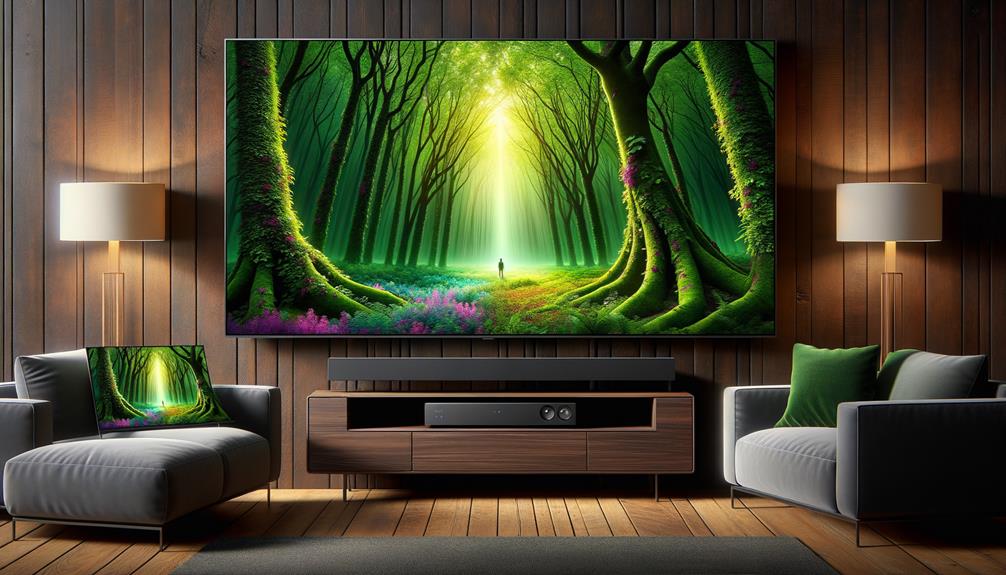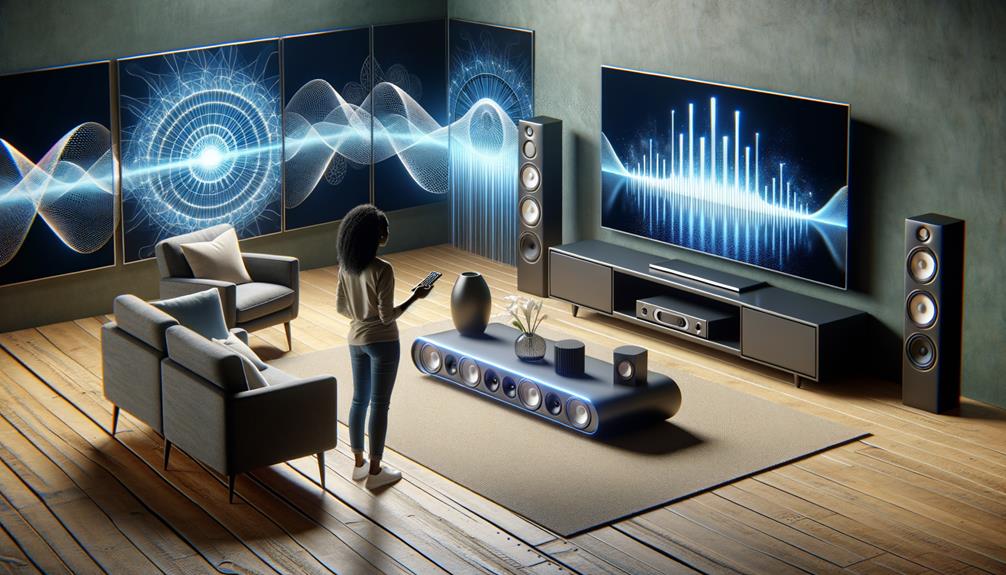
Choosing the right TV requires careful consideration of several critical factors.
Begin by evaluating the ideal screen size for your room, taking into account dimensions and viewing distance to guarantee comfort and clarity.
Explore screen technologies like OLED, which offers superior colour and contrast, or LED for energy efficiency.
For resolution, weigh the benefits of 4K against 8K; although 8K provides remarkable detail, 4K remains adequate for most users given current content availability.
Additionally, take into consideration smart features and audio options, which can greatly enhance your viewing experience.
Understanding these elements can lead to a decision that complements both your space and lifestyle.
Quick Summary
- Measure room space and viewing distance to determine the ideal TV size.
- Select a screen technology that suits your preference: OLED, QLED, or LED.
- Choose between 4K and 8K resolution based on budget and screen size.
- Evaluate smart TV features like automatic picture adjustment and integrated content hubs.
- Consider enhancing audio with external speakers such as soundbars or bookshelf speakers.
Determining Optimal Screen Size
To select the best TV screen size, one must consider the dimensions of the room and the typical viewing distance to guarantee a comfortable and immersive viewing experience.
Measuring space is important in determining this ideal size.
A general guideline suggests that for a viewing distance of 6 to 8 feet, a TV between 55 and 75 inches will likely be suitable.
The relationship between screen size and viewing distance is directly proportional, meaning as the distance increases, so should the screen size for best viewing.
Additionally, considering viewing angles is essential; the screen should be visible without strain from any point in the room.
Thoroughly evaluating these elements ensures the selection of an appropriately sized TV for any space.
Understanding Screen Technology
As technology advances, various screen technologies such as OLED, QLED, and LED have emerged to enhance the visual experience of television viewers.
Understanding the differences, particularly in the debate of OLED vs QLED, is important for making an informed choice.
OLED TVs are known for their ability to deliver perfect contrast with individual pixel backlighting, allowing for vivid colours and true blacks.
In contrast, QLED TVs use Quantum Dot technology to boost colour accuracy and brightness significantly.
| Technology | Key Feature | Ideal Use |
|---|---|---|
| OLED | Individual pixel control | Movie watching in dark rooms |
| QLED | Enhanced color and brightness | Bright rooms |
| Neo QLED | Mini LED technology | Precision in brightness and contrast control |
| LED | Energy efficiency | General, cost-effective viewing |
| Lifestyle | Customisable aesthetics | Decorative environments |
The introduction of Neo QLED with its Mini LEDs offers enhanced control over brightness and contrast, standing as a notable benefit of this technology.
Choosing Between 4K and 8K

When making a choice between 4K and 8K TVs, it’s important to consider both the resolution benefits and the current availability of content.
A resolution comparison reveals that 8K TVs offer four times the pixels of 4K TVs, which translates to sharper and more detailed images.
However, content availability for 8K is currently limited, making 4K a more practical choice for most users due to its broader range of accessible media.
Additionally, budget considerations are significant. 8K TVs generally come with a higher price tag, which may not align with every consumer’s financial plan.
Screen size suitability also plays a critical role; larger screens benefit more from the increased resolution of 8K, enhancing the viewing experience on expansive displays.
Evaluating Smart TV Features
Smart TVs integrate advanced features that enhance user interaction and viewing quality, adapting to different environments for best display performance.
Smart TV compatibility with various devices and voice control functionalities amplify the ease of use, providing a seamless integration into your digital lifestyle.
Key features to evaluate include:
- Automatic Picture Adjustment: Adapts settings for best viewing based on environmental conditions.
- Cutting-Edge Display Technology: Choose from models like Samsung’s Neo QLED 8K & 4K and OLED for superior picture quality.
- Integrated Content Hub: Access all your entertainment through a single interface.
- Privacy and Data Collection Policies: Understand how your data is used and what control you have over privacy settings.
These elements are essential for a full Smart TV experience.
Assessing Audio Options

While evaluating smart TV features guarantees an enhanced visual experience, analysing audio options is equally important to complement the overall quality of your home entertainment system.
Many TVs come with built-in speakers that often deliver subpar sound quality.
Upgrading to a sound bar or bookshelf speakers can greatly enhance audio clarity and output, ensuring a more immersive viewing experience.
Sound bars are particularly beneficial due to their advanced sound formats and smart features.
Additionally, considering speaker placement and sound customisation capabilities is essential for optimising audio performance.
Look for models offering extensive connectivity options, including wireless compatibility, to easily integrate with other devices in your home entertainment setup, allowing for a more streamlined and flexible user experience.
Comparing Top TV Brands
Evaluating the leading television manufacturers, Samsung, LG, Sony, Panasonic, and Philips each bring unique features and technologies to the market.
Samsung’s QLED and Neo QLED models excel in vibrant color accuracy, ideal for vivid viewing experiences.
LG’s OLED TVs offer unmatched black levels and contrast, enhancing both gaming performance and cinematic viewing.
Sony combines their renowned image processing with superior LED and OLED displays, ensuring high color accuracy and smooth gaming.
Panasonic and Philips enhance their offerings with advanced HDR standards and unique features like Ambilight, respectively, which improve immersive viewing.
Key aspects for top-notch performance include:
- Color accuracy for realistic images.
- Gaming performance with low input lag.
- Contrast ratios for deeper blacks.
- Smart features for enhanced usability.
Frequently Asked Questions
How Do I Figure Out What TV to Buy?
To determine the suitable TV purchase, assess budget considerations and room size. Evaluate resolution, refresh rates, and whether OLED or QLED suits your needs for the best viewing experience and functionality.
What to Consider When Buying a Smart TV?
When purchasing a smart TV, assess voice control responsiveness and app compatibility to guarantee seamless integration with your digital lifestyle. Prioritise models that support a wide range of applications and effective voice command features.
What to Look for When Buying a New TV in the UK?
When purchasing a new TV in the UK, consider energy efficiency ratings to reduce power consumption and cost. Additionally, ideal viewing distance should align with screen size for the best visual experience.
What Is the Most Popular TV Size in the UK?
The most popular TV size in the UK is 55 inches, reflecting ideal size trends and viewing distance considerations for the typical living space, balancing immersive viewing with spatial constraints in most households.
Conclusion
To sum up, choosing an appropriate television involves a thorough analysis of various factors including:
- Screen size
- Technology
- Resolution
- Smart features
- Audio capabilities
A balanced consideration of these elements guarantees an excellent viewing experience.
Moreover, a detailed comparison of leading brands based on:
- Performance
- Durability
- Consumer support
is essential.
Ultimately, well-informed decisions based on technical specifications and personal usage requirements will lead to a satisfactory purchase in the rapidly evolving television market.
